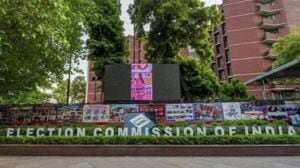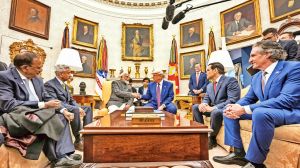Know Your City: Ahmedabad’s iconic Sardar Patel Bhavan
Even as the city grew from a population of 11.5 lakh in 1960 to a population of nearly 50 lakh by 2000, the building continued to function as its nerve centre till 2010, with almost the similar number of departments as there are now.
 Exteriors of Sardar Patel Bhavan which houses the heritage department. (Express Photo)
Exteriors of Sardar Patel Bhavan which houses the heritage department. (Express Photo) On the busy road connecting Ellisbridge and Astodia in old Ahmedabad, an ochre coloured multi-arched building named after Sardar Vallabhbhai Patel stands tall.
Built in 1885, it was first called ‘Ripon Building’ and housed the municipality offices. Even as the city grew from a population of 11.5 lakh in 1960 to a population of nearly 50 lakh by 2000, the building continued to function as its nerve centre till 2010, with almost the similar number of departments as there are now.
As the road outside it gets busier, one can feel the building vibrate, according to Director of the Ahmedabad Heritage Department Ashish Trambadia.
 Exteriors of Sardar Patel Bhavan which houses the heritage department
Exteriors of Sardar Patel Bhavan which houses the heritage department
“Definitely there was a road built and vehicles used to move outside. But, the movement was not so heavy. Now, given the heavy traffic movement just outside the road, and the steel structure of the building, one can feel ‘vibrations’ while sitting in the office,” says Trambadia.
The first president of the municipality installed by the erstwhile British government was Ranchhodlal Chhotalal, who also founded Ahmedabad’s first textile mill. While Rao Bahadur Bhaishankar Nanabhai became the first elected president of the municipality in 1915.
 Timber wooden staircase
Timber wooden staircase
Beginning from the protest against the Rowlatt Bills in 1919, the Ahmedabad Municipality became intertwined with the Indian national movement, writes Kenneth Gillion in his book ‘Ahmedabad, A Study in Indian Urban History’.
In 1917 Sardar Vallabhbhai Patel was elected to the Municipal Commission and, in 1924, he was elected president of the municipality. The Ahmedabad Borough Municipality came into existence in 1925 and Ahmedabad Municipal Corporation came into existence in 1950. And Sheth Chinubhai Chimanlal was the first mayor after the position replaced the president post.
The central hall of the Municipal Corporation was named ‘Gandhi Hall’ and the administrative building of the corporation was named ‘Sardar Patel Bhavan’. Till the building was in use, the mayor sat on the imposing timber chair used by presidents and mayors of the city body, since the time of Sardar Patel. This room has largely been kept intact with its wood flooring and the walls of the room are used for displays and exhibitions. It could accomodate upto 162 councillors, with a gallery for the audience having a capacity of 20, according to BJP leader Jayantilal Parmar, who served as the chairman of the AMC standing committee in the early 2000s when he was with the Congress.
The building’s design is based on “jack arch design,” with “I” shaped steel pillars connecting the arch.
“The beams are made of steel which provide this building flexibility, strength and serviceability to the building structure. Such technique is used for large slab construction as it is here. The other way to build on such a large span is with the help of a dome design, to have a big hall like this,” said Trambadia.
Trambadia says that they are still looking for records on who built the building.
 Exteriors of Sardar Patel Bhavan which houses the heritage department
Exteriors of Sardar Patel Bhavan which houses the heritage department
The second floor of the building houses the council room, which is made entirely of timber. The staircases of the heritage Department are also made of timber.
The construction material used was lime and stone. “This building is a mixture of traditional timber roofing system, load bearing brick walls, and segmental arches. The corridor is full of small segmental arches. The walls are about two feet thick, supported by an arched corridor, and extended corridors on the side of the courtyard,” said the director.
The building has a double roof system, where the main roof is sloping and the balcony roof in the front is flat, so that water drops and collects on the flat roof for conservation purposes.
 Old picture of the building (Shared by Ashish Trambadia, Director heritage department)
Old picture of the building (Shared by Ashish Trambadia, Director heritage department)
The heritage department occupies the first floor of the building, which also housed the offices of the mayor and municipal commissioner.
After the 2001 earthquake, the Sardar Patel Bhavan was retrofitted and the exterior wall where the bricks were exposed were plastered in 2006.
“The steel beams provide a flexible and steady construction, also adding strength and serviceability to it. Some sort of sagging in the centre is also required. Sagging proves how safe the building is, every beam of any structure sags, as a part of the serviceability quotient of the building. More the sagging, the safer the structure. but that is calculation wise. However, sagging beyond a makes one feel unsafe under the beam, when standing in the middle of the floor,” said Trambadia.
Explaining why the vibrations from outside traffic are felt, Trambadia says, “The beam sags maximum in the centre and less on the sides, which are steady but tend to go a bit upwards. Hence, one can feel vibrations in the building, especially when standing on the sides, like in the office which is built on the side. And lesser, when standing in the centre. But some form of shaking or flexibility is kept in the building as part of serviceability.”
Steel was chosen to build the basic structure probably due to the “lack” of materials to build such a large span in the given design. “It is also probable that the steel used here came from abroad, and the idea to build the building with steel and timber came to the British, seeing timber clad ships used at that time,” says Trambadia.












